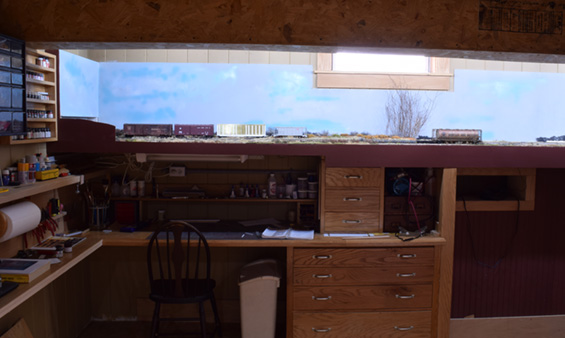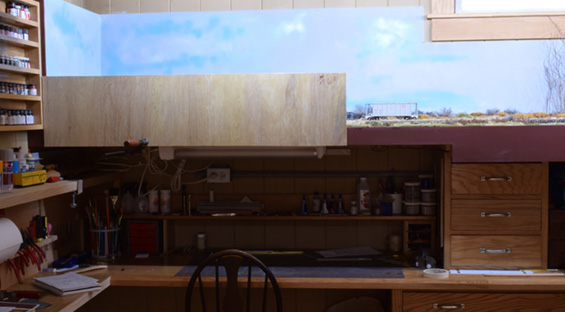It’s been a few weeks since I removed the curve and staging cassette and I’m happy to report that it was a good move. With a consistent appearance and operation the layout is better.
A concern I had about the change involved the loco being land-locked from its inability to leave the modeled area. I worried, would destroy the illusion?
The ability of a train to physically leave the modeled area is a great advantage especially on a small layout like the I&W. With this in mind, I frequently examined the potential of the area above my work bench before and after making the changes. This section consists of a tail track for the run-around along with the single yard track where the boxcars are sitting in the photo. This portion of the layout has always been vaguely unsatisfying and, despite several iterations with the track and scenery, it still nags at me and I’ve yet to pinpoint the real reason for my dissatisfaction. Therefore completing the scenery has lagged behind here.
Because of my dissatisfaction with the area, I’ve often considered stripping it down to just track and using it as off-scene staging. To that end, I mocked up some variations with the fascia that centered on hiding the trackage (photo below) and, I quickly confirmed that I strongly dislike running on track that is hidden. I could have reduced the height of the panel you see here but that would still hinder my access, making everything more difficult than it has to be, so I discarded this idea. This area is the first thing one sees when approaching the layout and a blank fascia panel isn’t the most attractive first impression, although I had ideas for enhancing the fascia panel as a way to introduce the layout if I had chosen this route.
What do I really want from staging?
Thinking about the function I want a staging area to perform, I realized that I didn’t need to hide an entire multi-car train. All I want is an unobtrusive place to park the loco that provides an impression that it has left the scene. Clarifying this opened up possibilities I wouldn’t have thought of otherwise. It dawned on me that the tail track would serve that function and I could model a dense stand of trees and shrubs on the front edge of the layout that would effectively screen the loco by drawing my attention away from it but allow me to track its progress. I used a similar treatment on the end of the curve where trains entered the staging cassette and it worked well. It also means less construction upheaval as no trackage needs to be altered. Further, I could leave an open area to throw the switch points or couple/uncouple cars. A cluster of trees would also make a nice first impression.
From my post of April 29, this is an example of how a design choice serves my criteria and enhances the experience of the layout, instead of forcing me into unsatisfying compromises to fit some preconceived solution. By having the tail track on this end of the passing siding serve more than one purpose, I expanded the operating potential without the expense or disruption from adding more square footage to the layout. In all it feels like the right way to go.
I hasten to add that this is an old idea that has been used effectively by many others. It does demonstrate the power of ideas though. I initially found myself hamstrung by the idea of staging as something separate from the layout rather than integrated into it. This rigid thinking is what kept me from removing the curve sooner because I didn’t know where else to put a separate staging cassette or area. Once I was free of my preconceived notions of what staging is or isn’t, the decisions were simple.
If had found a better solution that involved remodeling this end of the layout, I would have done so but for now, things are in a good place. I have plenty of projects to keep me occupied and there is no pressure to change anything. That’s my definition of a Freedom Layout.
Regards,
Mike


Good morning Mike
In these focused layouts, like you’re building, I get a sense that they really shine when the play they stage is the one that tells the story of how the railroad served a particular event, in this particular place, at this time, and on this day. We think we need staging because we can’t escape a compulsion to tell the whole story from start to finish and we need to model the whole life cycle of the car load of grain we’re switching right now. We can’t just model the feed mill on our layouts without representing each step from the farm to the mill. We add staging to represent a place where the farmer harvested the grain, loaded it into the railcar, and all those exciting places the car travelled through on its way to this particular siding on our model railway. Is that too big a story?
What attracted us to this siding in the first place? Placing a hundred ton railcar using an equally massive locomotive on track this delicate is something that only a skilled crew can do. We were drawn here to experience a crew so schooled in their craft that they just knew when to punch the throttle and when to back off. We’re modeling this particular scene because we’re compelled by that moment. On plywood and in model form, we’re doing this hoping that others can share in this time so special to us. We want to tell them about what happens on those days at that time because we knew we’d catch the train “in the act”. When we watched that vintage diesel nosing that car into place we forgot that this train came from somewhere. We weren’t paying attention to the load or even the car type. One by one these attributes fade as our attention is ever more focused on the relationship between the ground, the track, the train, and how it’s all affected during this moment. Right now.
Maybe we don’t need the staging at all because what we’re modeling what happens here, at this time, and only a couple of times a month; modeling what’s so special about right now, right here. It doesn’t matter that the train came from Halifax or Altoona, or that it’s going to service Interlake Paper next. The magic is here and it is happening now. Once the train is done at the mill, they’ll run back out onto the main, close the switch and leave. We won’t see that because we’ll leave too. We’ll hop back on our bikes or into our cars and go back to our lives too. We could model this time when a train crew hope they’ll get away with shoving another hundred tons of whatever down that same siding without having to rerail that load…one more time.
I’m really enjoying these recent posts on the evolution of your layout and the refinement of your understanding of what it is and does. This is great stuff. Inspirational stuff.
Thanks
Chris
Thank you Chris.
Your comments speak to the heart of my view of the larger craft and of the I&W. Great insights thoughtfully expressed, as always.
Regards,
Mike
Hi Mike,
You do not need staging or a fiddle yard. I have been debating a similar situation with my “Beckleysville”. The extra space I gained from deleting the fiddle yard will help convey the story of a small rural terminal by adding recently plowed fields, a small stream, trestle and a row of trees at the end of the module. In an exhibition setup, the layout would need a fiddle yard but as a home layout with me and perhaps one of the kids, there is no need.
My operating session ends as the train leaves town. Session begins as train enters town. So I can just rearrange the train at the end of a session. The story is switching the several small industries in town.
Think about your operations and the story you wish to convey.
Matt
Tend to agree with you Matt. Since I’m not attempting to stage an entire train or multiple trains, I do not need a dedicated staging area. Your comment highlights the importance of thoroughly understanding your own objectives rather than being a slave to conventional thinking.
Thanks for writing in.
Mike